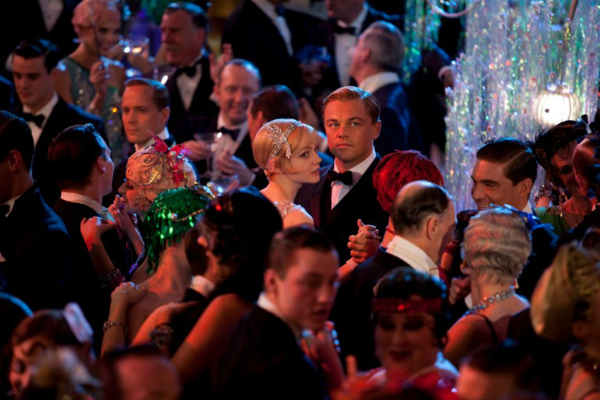Movie review by Greg Carlson
F. Scott Fitzgerald’s “The Great Gatsby” receives its fourth theatrical feature adaptation (for whatever reason, the forgotten 2005 “G” is not included on that list) along with the Baz Luhrmann treatment, an expectedly anachronistic bricolage that marginally improves on the somnolence of the 1974 version directed by Jack Clayton. Mostly faithful in major plot detail and too faithful in the relentless use of “old sport” as Gatsby’s favorite term of endearment, Luhrmann’s edition spares no expense in conjuring up a simulacrum of Jazz Age extravagance and conspicuous consumption. The movie’s brio fails to develop into a “spectacular spectacular,” however, and like Gatsby’s doomed quest, no amount of money can buy the viewer’s love.
The 1998 Greenhaven Press compilation “Readings on The Great Gatsby” addresses Gatsby’s nature by presenting a quintet of essays arguing that the man is variously a classic romantic, a sinister gangster, a profoundly comic character, a pathological narcissist, and a fairytale hero for the middle class. Leonardo DiCaprio doesn’t get at each of these positions equally, but his portrayal effectively encapsulates Gatsby’s neediness and desperation for love and approval that never arrive. Of course, it is Nick and not Daisy who comes closest to validating Gatsby’s desire (“You’re worth the whole damn bunch put together.”), but Luhrmann doesn’t press the homoeroticism of the Jay-Nick bromance, extra-textually stimulated by DiCaprio and Tobey Maguire’s foundational membership in the coarsely named Pussy Posse.
Daisy Fay Buchanan, the shallow and capricious committer of vehicular homicide, is arguably the Gatsby character most resistant to cinematic translation. Mia Farrow’s disastrous interpretation left much to be desired, and Carey Mulligan strains to make the most of her very scarce opportunities to instill complexity in a young woman so idealized by her onetime suitor she cannot possibly live up to Gatsby’s expectations. The romance of “The Great Gatsby” has always struck me as a terrible, rotten mirage, and its fundamental emptiness and fraudulence – a key part of Fitzgerald’s tragedy – presents a major adaptation obstacle.
Those who accept the novel as sacred canon will despise Luhrmann’s big alterations, most glaringly manifested in a poorly conceived and wretchedly executed framing device that places Nick Carraway in a sanatorium as he “writes” the story of Gatsby as a kind of purgation of his alcoholic and melancholic demons. The gimmick gives Luhrmann and co-screenwriter Craig Pearce an excuse to slather on what feels like pages and pages of extraneous voiceover narration presumably included to honor Fitzgerald’s poetic cadences. In case we miss the point, Luhrmann superimposes the text of key passages and quotations directly onscreen.
Considering Shawn Carter’s producing credit and soundtrack presence, it obviously occurred to Luhrmann that Jay-Z’s Marcy Projects to Madison Square Garden trajectory mirrors the Horatio Alger-esque, self-made journey of Gatsby. In her “New York Times” column, Maureen Dowd quoted Leon Wieseltier, who “thinks it’s time for a black Gatsby.” Luhrmann retains Fitzgerald’s references to race, including the moment when Nick and Jay are passed on the Queensboro Bridge by a limousine “driven by a white chauffeur, in which sat three modish negroes, two bucks and a girl.” The scene in the film is underscored by Jay-Z’s “Izzo (H.O.V.A.),” and serves as a reminder of the gulf between the wealthy white Roaring Twenties aristocracy and the artists and innovators of the Harlem Renaissance.
